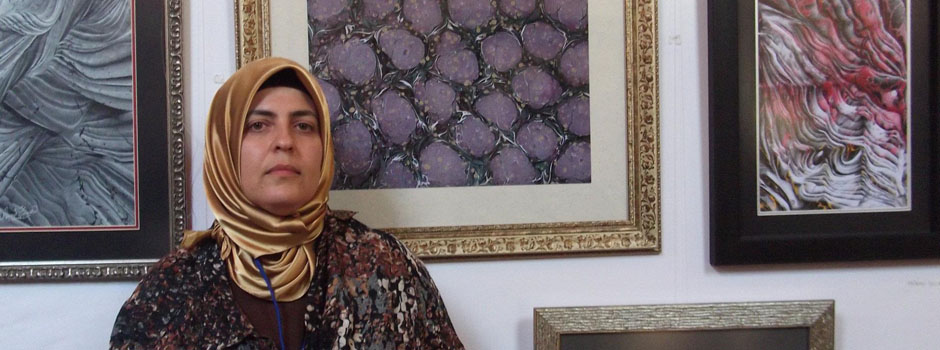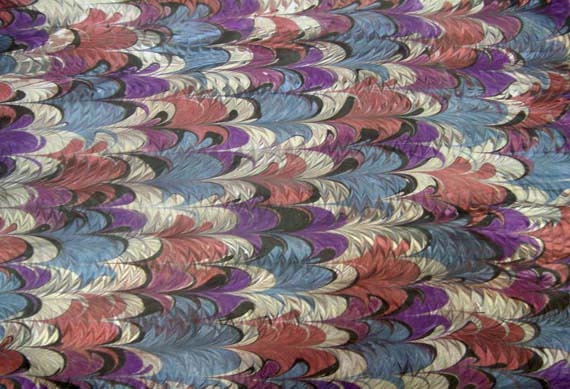
AN INTERVIEW WITH TURKISH ARTIST SONGÜL SÖNMEZ The Unique Art of Ebru (Marbling)
Apr 03, 2012 Interview

I was born in 1962. I graduated from Turkish Literature Department of Hacettepe University in Ankara. I learned the ebru art in 2002 and at this point my art career started. I have worked with Meral Özcan, also an ebru artist, to improve my art skills. She is a professional, so I learned a lot from her. I was not only studying with Mrs. Özcan, but also attending ebru courses in the City Hall where I received my art certificate from the Ministry of Culture.
In 2008 I received an 'honorable mention award' for my ebru in an art competition which was arranged by the Ministry of Culture. My work has been exhibited in many exhibitions all over the Turkey. I am making my art and teaching it, having a workshop in Historical Hamamönü Houses in Ankara. At the same time I am teaching ebru in City Hall's educational courses.
.jpg) Songül Sönmez receiving the award / Image: Courtesy of the Artist
Songül Sönmez receiving the award / Image: Courtesy of the Artist
In my opinion ebru art is the most compatible with us and our nature. Colours and water have an important effect on human psychology and human soul. Ebru is a technique that permits new things to happen, so we can easily be surprised. In other arts, the artist can plans and designs art work before executing it, as in ebru only the water and colours are adjusted by the artist, the rest of the process is led by knowledge and intuition. So, the result is generally unexpected.
The water is the source of life. Allah has created the universe from the water, and He also created colours. By mixing them we can get a beautiful colour shades and we can create an amazing world, based on the colours. Moreover, the artist’s mood has an important impact on the creation of the ebru, by selecting the colours and choosing the shapes. After using same colors and creating same patterns, we can get a similar ebru, but never the same, since each ebru is unique. It can’t be repeated exactly the same again. This attracts me and makes me interested.
.jpg) Songül Sönmez / Dalgal Ebru, 30x42 cm, 2008 / Image: Courtesy of the Artist
Songül Sönmez / Dalgal Ebru, 30x42 cm, 2008 / Image: Courtesy of the Artist
The meaning of ebru can shortly be described as the method of scattering insoluble paint over a dense water to achieve marbled paper. We don’t know the exact time in history when ebru art was invented, but we do know that some of the oldest ebru was done already in 9th century. Ebru was brought to Anatolia from Persia and Turkistan through the Silk Road. In 16th century European voyagers brought this art to Europe, especially to Germany, France and Italy. The art was called 'Turkish Marble Paper' or ‘Ebru’.
The first known text about ebru art is 'Tertib-i Risale-i Ebri' by Şebek Mehmet Efendi, written in 1615. Mehmet Efendi created a ‘Floral Ebru’. In 19th century Şeyh Sadık Efendi with his sons and his students continued this tradition and in 20th century Necmettin Okyay achieved great development of this art. He created a new style of ‘Floral Ebru’ now known as 'Necmettin Ebrusu'. Mr. Okyay passed his knowledge to his sons Sami Okyay and Sacid Okyay and his nephew Mustafa Düzgünman who added a daisy and has developed other floral ebru techniques. Nowadays, this tradition is continued by Düzgünman's students, as a chain of teaching.
.jpg) Songül Sönmez / Damlatma Kumlu Ebru, 30x42 cm, 2011 / Image: Courtesy of the Artist
Songül Sönmez / Damlatma Kumlu Ebru, 30x42 cm, 2011 / Image: Courtesy of the Artist
Traditional ebru art is based on special techniques and named by it: Large Ebru (Ancient Large, Scattered Large, Naphta Large), Tide or Wave Ebru, Shawl Ebru, Comb Ebru, Floral Ebru, Nightingale Nest Ebru, Light Ebru, Sandy Ebru, and Written Ebru (combined with calligraphy). An ebru artist has to know all traditional techniques. The most basic and important one is ‘Large Ebru’. In this technique an artist should make the colours and tonality consistent with each other. ‘Large Ebru’ is the most basic form of ebru but learning it takes a lot of time. After learning the basic techniques, the artist can create new techniques.
 Songül Sönmez / Tarkl Ebru / Image: Courtesy of the Artist
Songül Sönmez / Tarkl Ebru / Image: Courtesy of the Artist
Actually, I use many techniques that help me create new techniques and styles. For example, many ebru artists make a ‘Floral Ebru’ with a rose, but the way I do it is very specific. The same goes for other techniques. The most important is to create the harmony between the water, the colors and the quality of air. We should be aware that Allah’s help is the most important.
_.jpg) Songül Sönmez / Hatip Gül Ebru (Preacher Rose), 30x42 cm, 2011. / Image: Courtesy of the Artist
Songül Sönmez / Hatip Gül Ebru (Preacher Rose), 30x42 cm, 2011. / Image: Courtesy of the Artist
 Songül Sönmez / Floral Ebru, 30x42 cm, 2011 / Image: Courtesy of the Artist
Songül Sönmez / Floral Ebru, 30x42 cm, 2011 / Image: Courtesy of the Artist
That ebru was made in ‘Wavy Ebru’ technique. Other artists are making ‘Wavy Ebru’ as well, but I have developed a special technique. This ebru was executed in four steps: after the first colours dried, the second colours were applied; then the third and lastly the fourth colours. Finally, the ebru looked like a fire. Allah has helped me create this ebru. I have done similar art works but such an exquisite ebru is hard to achieve, even if you spend a lot of time trying.
_570.jpg) Songül Sönmez, ‘Wavy Ebru’ / Image: Courtesy of the Artist
Songül Sönmez, ‘Wavy Ebru’ / Image: Courtesy of the Artist
In recent years, marbling has become one of the famous and popular arts due to the numerous exhibitions and the mass media such as television, magazines and internet. People are interested so there are many courses, especially the City Hall plays important role to arrange these courses. In elementary school, children take elective courses such as music and painting, but in the painting course, children can learn marbling if they want. Also in some departments of universities such as Turkish Crafts Departments, students can learn ebru.
.jpg) Songül Sönmez / Mozaik Ebru, 30x42 cm, 2011 / Image: Courtesy of the Artist
Songül Sönmez / Mozaik Ebru, 30x42 cm, 2011 / Image: Courtesy of the Artist
_.jpg) Songül Sönmez / Kaplan Gözü Ebru, 30x42 cm, 2011 / Image: Courtesy of the Artist
Songül Sönmez / Kaplan Gözü Ebru, 30x42 cm, 2011 / Image: Courtesy of the Artist
.jpg) Songül Sönmez / Kumlu Ebru, 35x50 cm, 2012 / Image: Courtesy of the Artist
Songül Sönmez / Kumlu Ebru, 35x50 cm, 2012 / Image: Courtesy of the Artist
Today's famous ebru artists are: Alpaslan Babaoğlu, Fuat Başar, Nuri Pınar, Mahmut Peşteli, Timuçin Tanaslan, Meral Özcan, Firdevs Çalkanoğlu, Tuba Balcıoğlu, Nedim Sönmez,Bahtiyar Hıra. All of them have created some new techniques and are very talented. Mahmut Peşteli is the student of Fuat Başar; Nuri Pınar Yıldırım built his reputation with his ‘Wave Ebru’; Meral Özcan has improved ‘Dropped Ebru’ and Nedim Sönmez mixes marbling with painting and creates a new ‘Modern Ebru’; Firdevs Çalkanoğlu, Bahtiyar Hıra and Tuba Balcıoğlu improved ‘Floral Ebru’, trying new techniques, never tried before; and Hikmet Barutçugil creates and improves his special technique known as 'Barut Ebru'or ‘Powder Ebru’.
Comments
Apr 06, 2012 - 9:10:40
Could you please let me know how I can contact Songül Sönmez. An email address would be great.
Apr 05, 2012 - 21:39:51
Beautiful artform and a talented artist! I just love Songül Sönmez’s unique interpretation of this traditional art. Thank you for sharing!
Apr 03, 2012 - 22:17:24
My daughter took lessons from Nuri Pinar and discovered she had a special talent in creating ebru. Being an American, she drew much attention in this beautiful world of ebru!
Add a comment